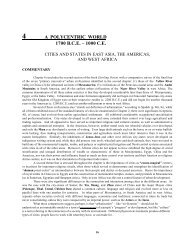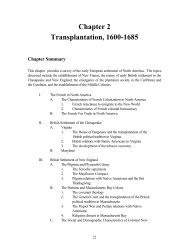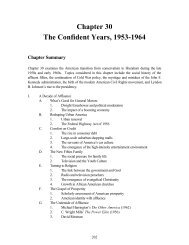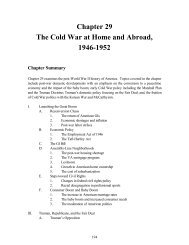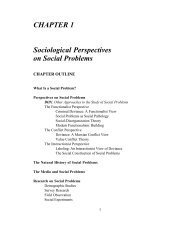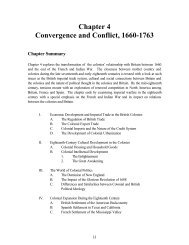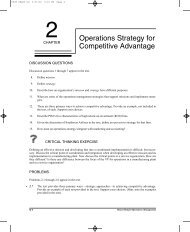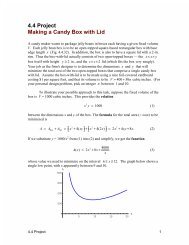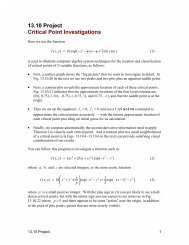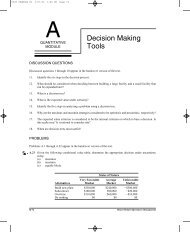Merchandising Operations and the Accounting Cycle - Pearson
Merchandising Operations and the Accounting Cycle - Pearson
Merchandising Operations and the Accounting Cycle - Pearson
You also want an ePaper? Increase the reach of your titles
YUMPU automatically turns print PDFs into web optimized ePapers that Google loves.
Two Key Ratios for Decision Making<br />
Merch<strong>and</strong>ise inventory is <strong>the</strong> most important asset to a merch<strong>and</strong>ising business<br />
because it captures <strong>the</strong> essence of <strong>the</strong> entity. To manage <strong>the</strong> business, owners <strong>and</strong><br />
managers focus on <strong>the</strong> best way to sell <strong>the</strong> inventory. They use several ratios to<br />
evaluate operations, among <strong>the</strong>m gross margin percentage <strong>and</strong> rate of inventory turnover.<br />
The Gross Margin Percentage<br />
A key decision tool for a merch<strong>and</strong>iser is related to gross margin, which is net sales<br />
minus cost of goods sold. Merch<strong>and</strong>isers strive to increase <strong>the</strong> gross margin percentage,<br />
which is computed as follows:<br />
For Austin Sound Centre Inc.<br />
(Exhibit 5-7)<br />
Gross margin<br />
Gross margin percentage =<br />
= $75,100 = 0.453 = 45.3%<br />
Net sales revenue $165,900<br />
The gross margin percentage (also called <strong>the</strong> gross profit percentage) is one of <strong>the</strong><br />
most carefully watched measures of profitability. A 45-percent gross margin means<br />
that each dollar of sales generates 45 cents of gross profit. On average, <strong>the</strong> goods cost<br />
<strong>the</strong> seller 55 cents. A small increase in <strong>the</strong> gross margin percentage may signal an<br />
important rise in income, <strong>and</strong> vice versa for a decrease.<br />
Exhibit 5-10 compares Austin Sound Centre Inc.’s gross margin to Wal-Mart’s<br />
gross margin.<br />
The Rate of Inventory Turnover<br />
Owners <strong>and</strong> managers strive to sell inventory as quickly as possible because it generates<br />
no profit until it is sold. The faster <strong>the</strong> sales occur, <strong>the</strong> higher <strong>the</strong> income.<br />
The slower <strong>the</strong> sales, <strong>the</strong> lower <strong>the</strong> income. Ideally, a business could operate with zero<br />
inventory. Most businesses, however, including retailers such as Austin Sound<br />
Centre Inc., must keep goods on h<strong>and</strong> for customers. Successful merch<strong>and</strong>isers<br />
purchase carefully to keep <strong>the</strong> goods moving through <strong>the</strong> business at a rapid pace.<br />
Inventory turnover, <strong>the</strong> ratio of cost of goods sold to average inventory, indicates<br />
how rapidly inventory is sold. Its computation follows:<br />
For Austin Sound Centre Inc.<br />
(Exhibit 5-7)<br />
Inventory Cost of goods sold Cost of goods sold $90,800<br />
= = =<br />
turnover Average inventory (Beginning inventory ($38,600* + $40,200)/2<br />
+ending inventory)/2<br />
= 2.3 times per year<br />
(about every<br />
159 days)<br />
*Taken from <strong>the</strong> balance sheet at <strong>the</strong> end of <strong>the</strong> preceding period.<br />
Inventory turnover is usually computed for an annual period, <strong>and</strong> <strong>the</strong> relevant<br />
cost-of-goods sold figure is <strong>the</strong> amount from <strong>the</strong> entire year. Average inventory is<br />
computed from <strong>the</strong> beginning <strong>and</strong> ending balances of <strong>the</strong> annual period. Austin<br />
Sound Centre Inc.’s beginning inventory would be taken from <strong>the</strong> business’s balance<br />
sheet at <strong>the</strong> end of <strong>the</strong> preceding year. The resulting inventory turnover statistic shows<br />
how many times <strong>the</strong> average level of inventory was sold during <strong>the</strong> year. A high rate<br />
of turnover is preferable to a low turnover rate. An increase in turnover rate usually<br />
means higher profits, but may sometimes lead to a shortage of inventory to sell.<br />
OBJECTIVE 5<br />
Use <strong>the</strong> gross margin percentage<br />
<strong>and</strong> <strong>the</strong> inventory turnover<br />
ratio to evaluate a business<br />
WORKING IT OUT<br />
Cavey Company Ltd. reports sales<br />
revenue of $3,000,000 <strong>and</strong> cost of<br />
goods sold of $1,800,000 for <strong>the</strong><br />
2002 fiscal year. Calculate<br />
(1) Cavey’s gross margin<br />
percentage for 2002, <strong>and</strong><br />
(2) Cost of goods sold as a<br />
percentage of sales for 2002.<br />
(3) What do <strong>the</strong>se percentages<br />
mean to Cavey management?<br />
A:<br />
(1) Gross margin = $3,000,000 –<br />
$1,800,000 = $1,200,000<br />
Gross margin percentage =<br />
$1,200,000/$3,000,000 = 40%<br />
(2) $1,800,000/$3,000,000 = 60%<br />
(3) Per dollar of sales, Cavey<br />
spends (on average) $0.60 to<br />
acquire or manufacture its<br />
products <strong>and</strong> it earns (on average)<br />
$0.40 of gross margin per dollar of<br />
sales revenue.<br />
Wal-Mart<br />
www.wal-mart.com<br />
EXHIBIT 5-10<br />
Gross Margin on $1.00 of<br />
Sales for Two Merch<strong>and</strong>isers<br />
$1.00<br />
$0.75<br />
$0.50<br />
$0.25<br />
Gross<br />
profit<br />
$0.21<br />
Cost of<br />
goods<br />
sold<br />
$0.79<br />
Gross<br />
profit<br />
$0.45<br />
Cost of<br />
goods<br />
sold<br />
$0.55<br />
Wal-Mart Austin<br />
Sound<br />
Centre<br />
Inc.<br />
Chapter Five <strong>Merch<strong>and</strong>ising</strong> <strong>Operations</strong> <strong>and</strong> <strong>the</strong> <strong>Accounting</strong> <strong>Cycle</strong> 245



